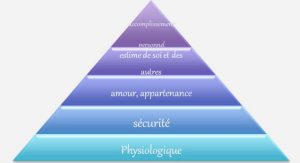GOOD AND EVIL IN WILLIAM GOLDING’S THE INHERITORS (1955) AND THE SPIRE (1964)
Characterization of Good and Evil
The shape of social life reflects the different behaviours adopted by human beings. The latter most of the time, is influenced by culture, civilization, and religion. That is the reason why it would be casual to examine mankind’s actions within society, without taking into consideration these significant elements that shape his life. In this framework Golding’s living in a world of archeologists or anthropologists and his experience in a religious environment, all these had a great impact on his view about human actions whether they are morally right or bad. In fact he uses different characters to point up the depravity of human beings as well as actions that are thought to be good apparently. This indirect characterization is done through a process in which we see a development characters and creation of their images to the benefit of the audience. This approach Golding usually uses in many of his writings shows us things or important information about the characters. And this can help us to have a better understanding of what is represented in terms of notions, concepts or ideologies. First of all it’s important to specify that such a characterization is just used as a matter of principle to show Golding’s perception about human nature. However some characters are associated with good in the form but their actions are not reduced exclusively in positivity. Therefore they are sometimes capable of doing bad things. In The Inheritors on the one hand, the notion of goodness and innocence is represented by Lok’s people known as Neanderthals. They have any evil feeling and their life is characterized by peace and wisdom. On the other hand, there are the New men who embody evil deeds. In The Spire this characterization is done in a different way because the Protagonist Dean Jocelin is a kind of synthesis of both good and bad forces. Nevertheless the other victimized characters such as Roger, 7 Pangall, Goody and Rachel can be considered in some extent as the ones who represent the notion of goodness or innocence. In this first chapter the issue of good an evil appears in both of novels with characters associated with goodness and the embodiment of evil by others.
Characters associated with Good
In The Inheritors, characters such as Lok and Fa who are part of the Neanderthal people embody the notion of goodness through their innocence. Indeed Neanderthal men are innocent without any evil feeling, they ignore violence and envy. Contrary to modern people, Lok’s tribe has not yet fallen because they adopt a way of living so close to nature. They are associated with goodness in so far they embody simplicity. If we observe their way of living, we notice that they are intuitive and instinctive. Indeed they embody natural life without any sense of evil. In other words they are considered as harmless creatures and do not understand violence that Tuami’s tribe makes upon them. They ignore offensive weapon and all kinds of material that are able to annihilate mankind’s life. In this respect we can say that concerning human behaviour there is resemblance between the attitudes of Lok’s tribe and Simon the most introspective character in Lord of The Flies. In The Inheritors the forest is appreciated by Fa when she argues that “The new people are frightened…They heave and sweat and watch the forest over their backs. But there is no danger in the forest”.4 This shows clearly that contrary to modern men, who are afraid of the forest, Lok’s people are fascinated by the forest and they even contemplate it. Of course this nature is a kind of incarnation of a divinity that is always associated with good attitudes and mercy. This affinity with nature cultivates in Neanderthal men a certain naivety. Because when the modern man has pointed the arrow towards Lok, he does not understand and even regard it as a gift: 4William Golding, The Inheritors, Faber and Faber, London, 1955.p 206. 9 “The man turned sideways in the brushes and looked at Lok along his shoulder. A stick rose upright and there was a lump of bone in the middle… The stick began to grow shorter at both ends then it shot out to full length again.”5 From this state of facts, Golding draws a distinction between the notions of innocence and stupidity. This pacific attitude of Neanderthal men in front of the modern people is something that must not be qualified as stupid reaction. It is understandable in the sense that in the Neanderthal world peaceful way of living is prevailing to the detriment of violence. The latter is unknown to Lok’s people hence its exclusion. As Simon in Lord of The Flies, Lok’s tribe considers the forest as something venerable. Instead of eating meat as modern people do, they prefer fungi which are an integral part of forest characteristics. They refuse eating meat unless something else has killed the animal beforehand and sucked the blood. And even in so doing, they feel guilty because for them the animals are integral part within the universe and the fact of killing them is associated with human bad behaviour. Through such a consideration we can say that Golding is trying to draw a close link between the notion of innocence and vegetarian ideology. In the course of the narrative he gives us a catalogue of Neanderthal virtues based on their natural and peaceful attitudes. This closeness to nature reflects the good attitude they adopt in an environment marked by spontaneity and innocence. In fact, they have some qualities that seem implicitly connected with the schoolboys right at the beginning of Lord of The Flies before their fall. So within Neanderthal world, it really exist affection between people and the latter is strongly excited by their lovable home which is a forest environment. In addition to that adoption of natural life, we notice the existence of certain sympathy within Neanderthal interactions. This is all the more true that when the most aged of them named Mal became ill, the whole group mobilized to try to care him. This benevolent and attractive action demonstrates not only the kindness of the group but also and mainly the reign of a sense of ritual and solidarity between them. This 5William, Golding, The Inheritors. Op. Cit. p 106. 10 solidarity is also visible via the considerable effort Lok and Fa have granted to their search of the Neanderthal girl Liku. The latter has been arrested by the new men group as a captive. And Lok and Fa who are the remaining innocents do all their best to rescue him but in vain. Unfortunately he has been killed and his flesh eaten. However this tireless support illustrates in a way or another goodness of Neanderthal men in terms of attractive and fraternal social interactions. The English writer Herbert George Wells describes the Neanderthal species in The Outline of History as devils. While through The Inheritors which is a parody of Well’s novel, Golding rejects this idea by labeling Neanderthals positively. He gives us depiction in which they are totally innocent and then victimized. In fact, the main focus is that the new people project evil toward them. Nevertheless, Neanderthal beings as described by Golding are physically like Wells’s creatures but the great difference between them lies in their nature. That is to say the attitudes they adopt in the society. To Golding’s point of views, they provide numerous virtues. Physically, to the eyes of modern people they are animal-like. The traits of Neanderthal men reveal their closeness to natural landscape. In fact they live in perfect harmony with nature and their life is characterized by a sense of sacredness. Moreover they possess sensory awareness that is much heightened and allows them to perceive something unknown to the new men. This is at the origin of Lok people’s moral superiority. They are creatures who are physically furry and their physiognomy is related to their exclusive existence in nature. For example we notice a kind of communication between Lok and his ears even though the latter is not a specific entity. Their senses allow them to avoid bad deeds and encourage them in the fact of doing positive actions without offending the law of the nature. From this point of view we see that the physical appearance of Neanderthal people is not casual. Only because it orientates them by participating strongly to the materialization of their positive actions. While new people use language as means of communication, Neanderthal men exchange through a telepathy that is inherent to their nature. Therefore their obvious 11 special ability to transmit their feelings each other in such a spontaneous way, is at the basis of their natural way of living. They are social creatures who embody the notion of communal mind that is clearly illustrated through the following passage: “One of the deep silences fell on them, that seemed so much more natural than speech, a timeless silence in which there were at first many minds in the overhang; and then perhaps no mind at all.”6 This telepathic awareness of Neanderthal community is collective and does not involve intellectual attributes. This means that their minds can easily join in case of need. So this union that exists within the group is a remarkable quality and permits them to live in harmony with nature. Their concern is with pictures and not with ideas because practicality is one of their special qualities. I fact their closeness to animals does not reduce them to a low level. On the contrary it reveals their superiority through their collective ability to transmit their feelings without disturbing the originality of the natural life. Through these representative characters or tribes who incarnate the notions of sympathy, solidarity and innocence, Golding tries to show in a classical narrative some moral values provided by Neanderthal species.
Evil embodiment
In The Inheritors the so called advanced people or modern men incarnate evil in so far as they attack and make violence upon the Neanderthals. One of their most prominent characteristics of their nature is that they are very violent. In fact “they project their own evil toward the Neanderthalers”10. The character Tuami is part of such a tribe, they have a big capacity for hatred and envy. Like the savage schoolboys in Lord of The Flies, they always hunt animals and kill human beings without pity. Through this wickedness that characterizes new men’s behaviour, they embody evil nature. Unlike Neanderthals who do not want to kill any being, the new men composed of Tuami, Marlan,Vivani…are eager of doing so. They find it reasonable to annihilate the lives of others for the sake of their survival. This can be illustrated through Stephen Medcalf’s words: “The new men eat a Neanderthal girl Liku, because they are hungry and do not care to eat the fungi and other things the Neanderthalers eat.”11 In their desire to destroy Neanderthals, the new men manifest a sort of hypocrite attitude. For when they kill freely almost all of them except Lok and Fa, they have taken with them the Neanderthal baby known as the New one. The latter is then fed by the fat woman Vivani. Strangely enough the whole group of new men gives love and affection to the baby. Their hatred toward Neanderthals community in one hand and their love for the baby in the other hand let us see an incomprehensible contradiction. This hypocrisy is integral part of their numerous defects. If we refer to the cannibalistic tendencies of Tuami’s tribe, we notice that they incarnate aggressiveness and savagery. They kill the little child Liku in a very sadistic way. And then they try to legitimate the murder. This negative image of Tuami’s group is also visible through their lust for power. 10 Stephen Medcalf: William Golging: Writers and their Works, Longman Group Ltd, London,1 975 p 16. 11Ibid. p 17. 17 In fact Tuami is not only a simple evil-intentioned character but also a thinker who have some political theories that are not in conformity with moral values. In this respect he makes plan to kill their harsh leader Marlan the Old man in order to become the leader of the group. A deep analysis reveals that in certain way that Tuami’s intentions are right similar to those of the wicked character Jack in Lord of The Flies who tried to kill their leader Ralph just to become his substitute. In fact it is important to mention that modern people society is characterized by a patriarchal system in which people do not stand together. As opposed to the Neanderthals who live in a perfect union, Tuami’s tribe adopts an individualist way of living. They embody selfishness and fear. In that sense they consider Lok’s people as devils or beasts. Such an illusion blinds them to see the reality. Evil is deeply rooted in their nature so much so that “the new men only get drunk together, and make savage love”12 .In other words we can say that their capacity to perpetrate wrong deeds to the detriment of good one, demonstrates that evil is inherent to their human nature. Their individualism suggests their lack of communion and solidarity between them. Their life is full of tensions and superstitious rituals and violence. To illustrate the existence of violence within new men’s society, it is important to remind that Tuami points an arrow to Lok and Liku is killed savagely. All these scenes demonstrate somehow that Tuami’s people represent many defects such as cruelty and aggressiveness. From this representation, Golding’s aim is to trace, in an allegorical approach the defects of modern human beings. Indeed he invites the defenders of human progress, to be aware of the existence of evil in human society and the spread of bad actions in a very lightning way. 12Stephen Medcalf: William Golding: Writers and their Works, op. Cit, p 18 18 In some extent, this embodiment of evil by this tribe is the efficient method by which Golding gives his point of view about human nature on the whole. And this presence of evil within new men’s life can be summed up through the words of Golding’s other character Ralph who weeps for “the end of innocence, the darkness of man’s heart.”13 The new men’s lack of moral values is also visible through their ritual ceremony. During this event they chop the finger of one of them. They believe in such illusionist rituals in such a way that they find it hard to be aware of the negative consequences. These sacrifices demonstrate in a way or another that depravation and superstitious beliefs are main characteristics of their way of life. Indeed this shows that their rituals are based on blood shedding and hatred. In addition to that superstitious life, their confrontation with the Neanderthals is marked by a setting up of a society in which killing and destruction occupy an important place. Evil is also visible through the savage love affair between Tuami and Vivani the fat woman. This sexual scene is depicted as if it was a fighting. It is marked by a presence of blood. In the action, feeling is dominated by lust and perversity gains over tenderness or love: “There was blood on the woman’s face and the man’s shoulder[ . . .] the fighting done and peace restored between them, or whatever state it was that it was restored [. . . ] they hunted down pleasure as the wolves will follow and run down horses [. . . ] as a fox will play with the fat bird she has caught, postponing the death because she has the will to put off and enjoy twice over the pleasure of eating.”14 Such an aggressive image demonstrates that they both incarnate evil in so far as they behave like animals in the way they satisfy their lust. Contrary to Neanderthals whose love act is marked by love and 13William Golding, Lord of The Flies. Faber and Faber Ltd, London, p 248. 14William, Golding, The Inheritors, Op. Cit. pp 176-177. 19 feeling sharing, Tuami and Vivani incarnate savage love. Therefore we can say that new men’s interactions are obviously shaped by violence and aggressiveness. On account of their capacity of inventiveness they possess many materials such as arrow, boats and knives. Unfortunately what they do not understand is that all these possessions are at the origin of the presence of conflict and hatred within their community. This shows how Golding draws people’s attention to the danger of invention. For it blinds human beings to reality and encourages them to believe naively in the fact that they are in control of the world. The spread of evil actions throughout the world constitute the drawbacks stemming from such a human illusion. A meticulous analysis of new men’s attitudes let us notice that they represent modern people. They behave in a very bad way as if they do not profit from civilization. Not only they perpetuate evil in the society but also they always try to justify their bad actions because they find them logic and acceptable. It is important to underline that the reign of insecurity is due to new men’s fear. For they take the Neanderthals as devils. That is the reason why they find it useful to put an end to the lives of Neanderthal. This erroneous perception of Tuami’s tribe is at the basis of disasters and conflicts that constantly present in the course of the narrative. The Inheritors points up the bestial attitudes of the so called advanced people. This representation of evil by Tuami’s tribe can be summarized through his meditation about the whole wrong actions they have perpetuated successively. He thinks of those multiple bad actions such as the killing of Nil, Ha as well as The Old Woman. Apart from this boring murder he is also obsessed by the kidnapping of Liku and the little baby known as The New One. Their life is also punctuated by the sacrifice of Liku and the attempted sacrifice of Tanakil. In other words he does a kind of retrospection about all the evil events that have taken place in their confrontation with the Neanderthal group. His consciousness lets him think of the disturbance they have settled up in an area that was beforehand peaceful and in a perfect harmony.
DEDICATION |






